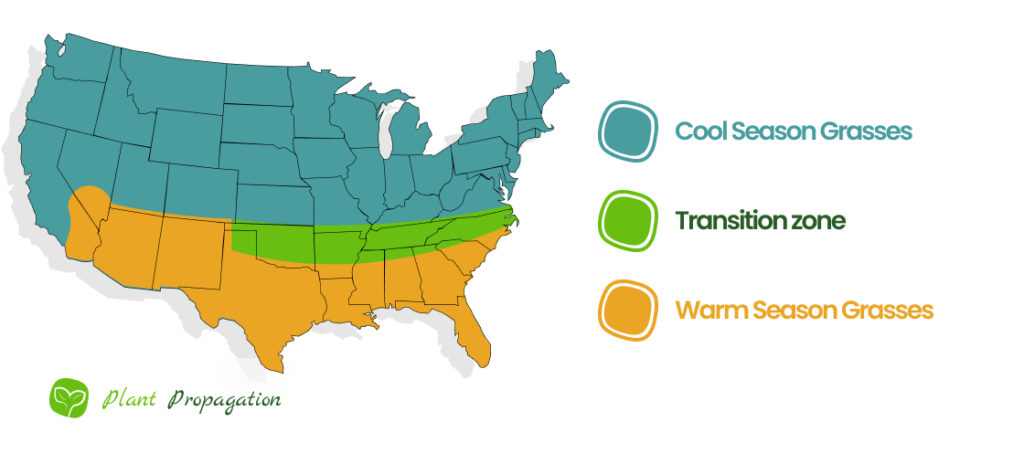Have you ever wondered how long it takes for grass seeds to transform into a lush, green lawn? Our experience over the years has shown that grass seeds start to grow after an average of 2 weeks, which is how long it takes for them to germinate.
However, their duration can vary greatly depending on when they are planted, the type and quality of grass, and the environment in which they are planted. In the United States, grasses are divided into 3 zones: cool-season, transition zone, and warm-season, with different ideal environmental factors. The growing season of grass depends on the zones.
The best time to plant grass seed varies by these zones and the environment. For example, cool-season grasses should be planted in spring and autumn, while warm-season grasses should be planted in mid-to-late spring when temperatures are warm enough.
What is the process of the grass germination?
The germination of grass starts with its planting. At this stage, they are still in the form of seeds in the ground. Continuous watering and temperature cause the outer shell of the seeds to open and the roots of the seeds to start growing. The roots provide the nutrients from the soil necessary for the grass to grow. To ensure germination, you should monitor the seeds every day, until you can see successfully germinated grass seeds. The average germination rate of grass is between 85% and 90%.
What are the seed types?
The grass seed types are divided into 3 types: cold-season grasses, transition zone, and warm-season grasses. Cold-season grasses are obviously perfect for colder areas, where the ground cannot warm up sufficiently and the grass has to withstand the physical stress. These include Kentucky Bluegrass, Fescues, Bentgrass, and Perennial Ryegrass.

Cold-season grasses can also be planted in transition zones. It is worth checking what color they are, they are usually darker in color. For example, Kentucky Bluegrass is medium-dark, while Tall Fescue tends to be lighter.
Warm-season grasses have their origin in the tropics and therefore require a warmer environment. This includes Bahia grass, Bermuda grass and Centipede grass. In fact, warm-season grasses can also be planted in the transition zone, but not all types survive. Bermuda grass and centipede grass are the most popular types for the transition zone because they are drought tolerant.
Select the grass seeds according to this diagram. If you live in the exact area of your choice, ask local experts what they recommend.
What are the fastest-growing grasses in each zones?

The table below shows the most popular grasses in each zone.
| Kentucky Bluegrass | Tall fescue | Bermuda | |
| Zone | Cool-season | Transition zone | Warm-season |
| Germination time | 14 to 30 days | 7 to 21 days | 3 to 21 days |
| Color | emerald to blue-green | dark green | green |
| Cold tolerance | Good | Good | Poor |
| Heat tolerance | Good | Good | Very good |
| Price | $31 (3 lb.) | $23 (3 lb.) | $13 (1 lb.) |
Which season should you sow the grass seeds?
You should sow grass seeds during the appropriate season for your specific climate zone. It is important to pay attention to how much the soil has warmed up and how much moisture it contains. On average, grass seedlings should be planted in mid-spring or early autumn, when the soil is in ideal condition due to the temperature of the soil.
How to prepare the soil?
The type of soil determines when the grass will grow. For example, cold-season grasses like a soil pH between 6.0 and 7.2. Moist conditions are essential for grass growth. To prepare the soil for seed dispersal, water the soil 1-2 days before sowing to create the right conditions for germination.
How much water does the grass need to grow?
Experts say that, on average, you should water your lawn until the top 6 inches or 13 centimeters are wet. Include rainwater in this calculation. You need to constantly monitor the color of the lawn. A yellowish color can indicate drying out, and this is usually accompanied by dry soil.
When should you water your grass?
You should water your grass between 6am and 10am. At this time the weather is cool enough, the sun doesn’t have the power to burn it, and it won’t rot because it’s not that cold and it warms up during the day.
What to do after germinating?
After germinating you should watch out for pests. In fact, this step is important for all plants. You can also fertilize to give the grass extra nutrients to strengthen it. Fertilization should be done in the fall to have an effect the following spring. Keep it clean of organic waste, such as pet droppings.
What are the essential tips for growing grass?
The most important tip for growing grass is moisture. Maintaining sufficient moisture is essential for germination and healthy growth, so that roots can grow strong enough in the soil and have a nice, defining color.
You can tell from the color of the grass if it is too dry or if it has been attacked by pests. Keep in mind the zones, which zone needs which conditions for happy grass growth. When mowing, be sure to leave the mower blades higher in the summer in areas with warmer climates, which will help shade the grass so it doesn’t burn out.
The grass has beautiful natural values due to its simplicity. It is often chosen in place of flowers because of its green color, and it is also very important for wildlife to have a living grassland.
